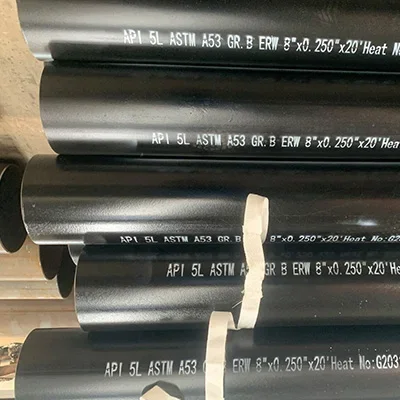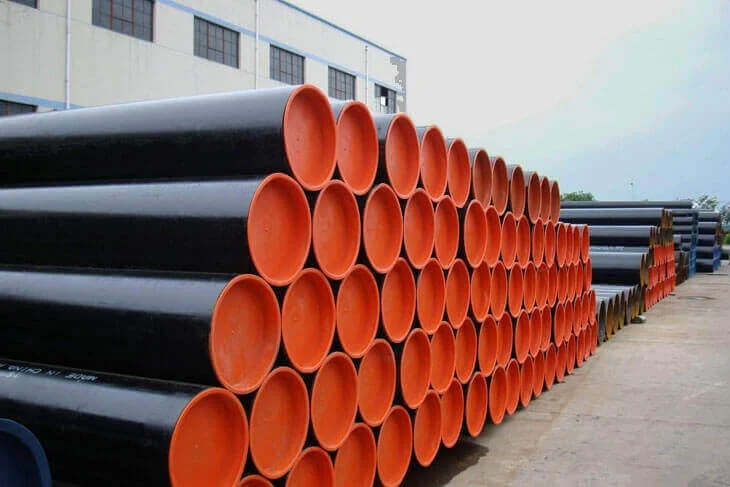CS Seamless Pipes: Where Durability Meets Efficiency
Carbon Steel Seamless Pipe, often abbreviated as CS Seamless Pipe, represent a category of steel pipes crafted from carbon steel devoid of any welded seams. The fabrication process involves piercing a solid cylindrical billet composed of carbon steel, thus forming a hollow tube. Subsequently, this tube undergoes further processing to attain the desired dimensions and characteristics. Carbon steel, the primary constituent, is an alloy primarily comprising iron and carbon, with trace elements like manganese, silicon, and sulfur.

These seamless pipes find extensive application across diverse industrial sectors due to their commendable attributes including robustness, strength, and resistance to corrosion. Notably, they are recognized for their impeccably smooth inner surface, facilitating efficient conveyance of fluids and gases. Carbon steel seamless pipes are available in a variety of grades, dimensions, and thicknesses, catering to a broad spectrum of industrial requirements. They serve multiple purposes, encompassing fluid and gas transportation as well as structural components in various industrial contexts.
Production Process of Carbon Steel Seamless Pipes
Selection and Quality of Raw Materials
The creation of Carbon Steel Seamless Pipes initiates with a meticulous selection of raw materials to uphold the final product's quality and performance. The primary constituent is carbon steel, typically composed of iron and carbon, alongside trace elements like manganese, silicon, and sulfur. The caliber of carbon steel holds paramount importance as it profoundly influences the ultimate strength and durability of the pipes. Manufacturers are obligated to adhere to precise standards and grades of carbon steel to satisfy industry prerequisites.
The Manufacturing Process
1) Extrusion
The manufacturing process takes its inception through extrusion. A solid cylindrical billet, composed of high-quality carbon steel, undergoes heating to attain malleability. This heated billet is then placed within an extrusion press, where it experiences significant pressure to propel it through a die, forming a hollow tube. This pivotal initial step is crucial in guaranteeing a seamless structure without any welded seams.
2) Rotary Piercing
Following extrusion, further refinement is achieved through rotary piercing. During this stage, the hollow tube undergoes rotary piercing to enhance its dimensional precision and surface finish. This step effectively eradicates imperfections and irregularities within the pipe.
3) Elongation
The subsequent step involves elongation, where the pierced tube undergoes elongation while simultaneously reducing its diameter. This process augments the mechanical properties of the pipe, such as tensile strength and hardness, all while preserving its seamless integrity.
4) Sizing and Cutting
After elongation, the seamless pipe is meticulously sized to align with the specified requirements. Sizing entails precise alteration, either reducing or expanding the pipe's diameter, to achieve the desired dimensions. The ultimate phase in the manufacturing process encompasses cutting the seamless pipe to its prescribed length.
Quality Control and Assurance in Production
Quality control and assurance stand as integral components of Carbon Steel Seamless Pipe production, guaranteeing the dependability and performance of the end product. Multiple measures are incorporated throughout the manufacturing process:
1) Non-destructive testing methods, such as ultrasonic testing and radiographic inspection, are employed to detect internal and surface defects within the seamless pipes.
2) Precise dimensional checks are conducted at various stages to ascertain that the pipe's dimensions align with industry standards.
3) Rigorous chemical composition analysis ensures that the carbon steel employed conforms to the specified grade and quality requisites.
4) Mechanical testing, encompassing assessments of tensile strength and hardness, is scrupulously carried out to affirm that the pipes meet or surpass the required standards.
5) Skilled inspectors meticulously scrutinize the pipes for surface irregularities, cracks, or imperfections through visual inspection.
6) Pipes are subjected to hydrostatic pressure tests to assess their resistance to internal pressure and confirm their structural integrity.
7) The entire manufacturing process is executed in strict accordance with industry and international standards, ensuring the quality and safety of the seamless pipes.
These stringent quality control measures and unwavering adherence to manufacturing standards affirm that Carbon Steel Seamless Pipes fulfill the exacting demands of diverse industrial applications while upholding their structural integrity and performance.
Characteristics and Benefits of Carbon Steel Seamless Pipes
Durability
1) Resilience to Wear and Tear:
CS Seamless Pipe is renowned for their exceptional durability, offering remarkable resilience to wear and tear. Their robust composition, primarily consisting of carbon steel, ensures that they can withstand the rigors of various industrial environments without succumbing to physical damage.

2) Resistance to Corrosion and Rust:
These pipes exhibit remarkable resistance to corrosion and rust, making them suitable for applications involving exposure to moisture, chemicals, and harsh environmental conditions. The inherent properties of carbon steel provide a protective layer, enhancing their longevity in corrosive settings.
3) Longevity and Lifespan:
Carbon Steel Seamless Pipes have an extended lifespan, often outlasting alternative materials. Their ability to resist deterioration from external factors contributes to reduced maintenance and replacement requirements, ultimately resulting in cost savings.
Efficiency
1) Smooth Interior Surface Promoting Fluid Flow:
The seamless nature of these pipes ensures a smooth interior surface, which facilitates efficient and unobstructed fluid flow. This characteristic is particularly advantageous in applications where fluid transportation efficiency is paramount.
2) Absence of Seams Reducing Potential Leak Points:
One of the notable advantages of seamless pipes is the absence of welded seams. This absence reduces the likelihood of potential leak points, enhancing the reliability and integrity of the piping system. It minimizes the risk of fluid or gas leakage, which can be a significant concern in various industrial processes.
3) Consistent Diameter Ensuring Predictable Performance:
Carbon Steel Seamless Pipes maintain a consistent diameter throughout their length. This consistency ensures predictable and consistent performance in fluid and gas transportation systems. It eliminates the need for frequent adjustments or maintenance due to dimensional variations.
Environmental Advantages
1) Reduced Need for Replacements:
The durability and longevity of Carbon Steel Seamless Pipes contribute to a reduced need for replacements. This, in turn, conserves resources and minimizes the environmental impact associated with the manufacturing and disposal of piping materials.
2) Recyclability of Carbon Steel:
Carbon steel is highly recyclable, making it an environmentally friendly choice. At the end of their service life, these pipes can be recycled and repurposed, reducing waste and conserving natural resources.
3) Energy Efficiency in Production:
The manufacturing process of carbon steel seamless pipes is relatively energy-efficient compared to certain alternative materials. This energy efficiency aligns with sustainable practices and reduces the carbon footprint associated with production.
Application and Uses of CS Seamless Pipe
Carbon steel seamless pipe is widely used across multiple industries due to their strength, versatility, and durability. Here's a detailed look at the applications and uses of these pipes in the listed sectors:
Oil and Gas Industry
1) Transmission Lines: Carbon steel pipes are commonly used to transport crude oil, natural gas, and refined products over long distances.
2) Drilling Operations: Due to their resistance to high pressures, they are used in drilling operations.
3) Downhole Casing: Protecting the walls of a well and ensuring smooth operations.
Heat Exchangers: In refineries, they play a crucial role in heat exchange processes.
Power Plants and Energy Sector
1) Steam Generation: Carbon steel pipes are used in boilers for carrying steam.
2) Condenser Tubes: They are used in power plants for cooling steam and turning it back into water.
3) Fossil Fuel Plants: Transporting water, steam, and gases.
Renewable Energy Plants: Geothermal stations utilize these pipes due to their ability to withstand high temperatures.
Construction and Infrastructure
1) Structural Use: Carbon steel pipes provide structural support in buildings, bridges, and other infrastructures.
2) Piling: Used as pilings for supporting large structures and buildings.
3) Fire Sprinkler Systems: Due to their durability, they are commonly used in sprinkler systems.
4) Gas Distribution: In cities and towns, these pipes play a vital role in gas distribution networks.
Mechanical and Automotive Industries
1) Manufacturing of Vehicles: Used in parts like chassis, axles, and other components.
2) Machinery: Due to their durability, they are used in various heavy machinery.
3) Hydraulic Systems: They are used in hydraulic cylinders and systems due to their ability to withstand high pressures.
4) Bearings: Seamless pipes are sometimes used to manufacture ring-shaped parts.
Water and Sewage Treatment Facilities
1) Water Transmission: Carbon steel pipes transport water to homes, businesses, and industries.
2) Sewage Collection: They are used to collect and transport sewage to treatment facilities.
3) Water Treatment Plants: In processes like filtration, sedimentation, and chemical treatment, these pipes play crucial roles.
4) Desalination Plants: Due to their resistance to corrosion (especially when coated), they can be used in certain desalination processes.
CONCLUSION
Carbon steel (CS) seamless pipe stands as a testament to the intersection of durability and efficiency in modern engineering and construction. Utilized across a vast spectrum of industries, from the oil fields of the Middle East to the water treatment facilities in urban cities, these pipes epitomize strength and functionality.
In conclusion, CS seamless pipe represents an amalgamation of durability and efficiency, setting a benchmark in the world of materials and construction. Their widespread application and unwavering performance are evidence of their unparalleled capabilities, firmly establishing their position as the backbone of numerous industries.






